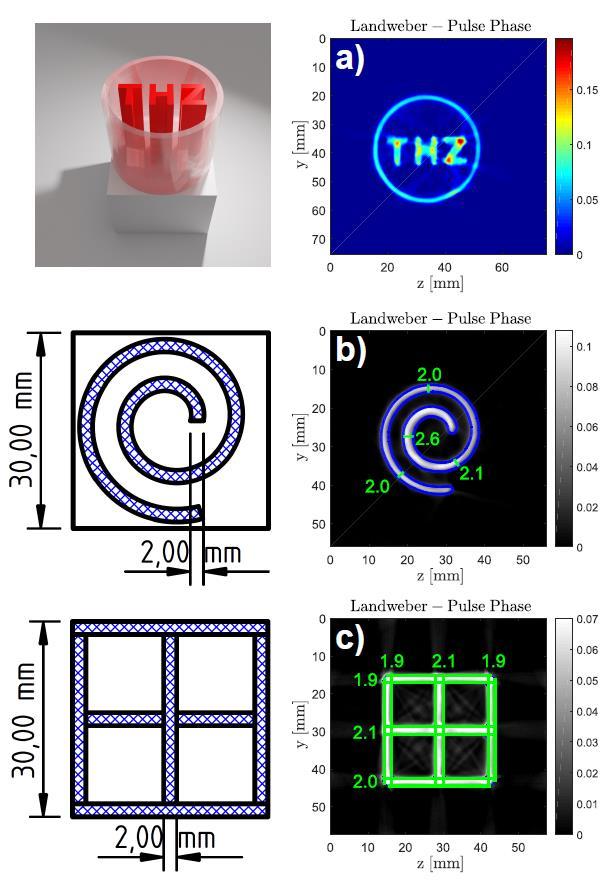
3 minute read
P. Fosoderer Phase contrast THz CT for non destructive testing
Phase-contrast THz-CT for non-destructive testing
Peter Fosodeder1, Simon Hubmer2, Alexander Ploier2, Sandrine van Frank1, Christian Rankl1 and Ronny Ramlau2 1Research Center for Non-Destructive Testing GmbH, Altenberger Straße 69, 4040 Linz, Austria 2Johann Radon Institute for Computational and Applied Mathematics, Altenberger Straße 69, 4040 Linz, Austria
Advertisement
Abstract— We demonstrate a robust implementation of a THzComputed Tomography (THz-CT) system for non-destructive testing of plastic profiles [1]. The main components of the system are a fast THz Time-domain spectrometer (THz-TDS) and a self developed image reconstruction algorithm based on an extended version of the Radon model – specifically developed to utilize the transmitted THz pulse phase. The reconstructed sample crosssections show excellent agreement within ±100 µm.
I. INTRODUCTION OTIVATED by the goal of reducing material losses during production and increasing the energy efficiency M in the extrusion process of plastic profiles, we investigate the possibilities for online non-destructive testing using THz-CT. The aim of this project is to build a THz CT setup and develop an accurate data evaluation algorithm for image reconstruction of highly complex plastic profile geometries.
Our THz-CT setup consists of a THz-TDS system in transmission geometry with sample translation and rotation stages. In contrast to classical X-ray CT, where the transmitted signal intensity is used for image reconstruction, our THz-CT system can additionally measure the acquired signal phase induced by the refractive index of the sample.
The interaction of THz radiation with the sample is generally described by Maxwell’s equations and is therefore strongly affected by diffraction and refraction on the sample surface. For this work, we have developed a modified version of the commonly known Radon model. We have further developed an algorithm to access the phase information, as it is specifically available in THz imaging. For our use-case of plastic profiles, it is shown that reconstruction based on phase information is superior to conventional intensity-based reconstructions. As shown in this work, the main reason for the increased robustness of our approach is that the measured pulse phase is not affected by diffraction and scattering. The development of a more advanced reconstruction algorithm, which further accounts for refraction is currently in progress.
II. RESULTS
In order to demonstrate the robustness of the developed approach, Fig. 1a shows a 3d printed (natural PolyPropylene) circular profile with the letters THZ inscribed and the corresponding phase contrast reconstruction (using Landweber iteration). The sample geometry is clearly identifiable.
For quantitative evaluation, two further samples with more ordinary geometries are presented. The quality attribute for each reconstruction is the sample wall thickness, compared to a mechanical reference measurement. Fig. 1b shows a linear spiral and the corresponding reconstructed image. The quantitative evaluation was done by thresholding and edge detection (blue line). It was found that the wall thickness of the inner structures of the spiral is inaccurately reconstructed as an increasingly thick wall. We state that this artifact appears as a consequence of refraction on the curved sample surface.
Fig. 1c shows a more realistic plastic profile, consisting of planar elements only. The sample boundary (green line) was detected by applying the linear Hough transform to the detected sample edges. Excellent agreement between the mechanical reference measurement within ±100 µm was found.
Fig. 1. Cross-sections and reconstructions of 3d printed plastic profiles. For qualitative demonstration, a complex sample with the letters THZ inscribed was reconstructed, yielding excellent agreement with the real sample geometry (a). Quantitative evaluation was done on a curved sample (b) and a planar sample (c). While the curved sample wall thickness deviates due to refraction artifacts, the planar sample could be reconstructed with an accuracy of ±100 µm.
REFERENCES [1] P. Fosodeder, S. Hubmer, A. Ploier, R. Ramlau, S. van Frank and C. Rankl, “Phase-contrast THz-CT for non-destructive testing, ” arXiv:2102.08650 [physics.app-ph], February, 2021. (available at https://arxiv.org/abs/2102.08650)









